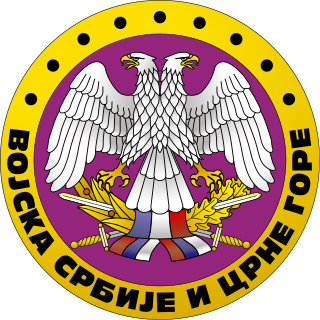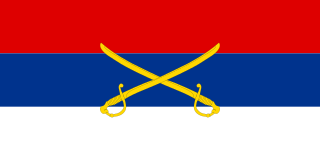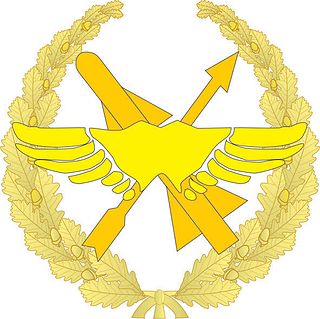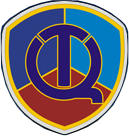
The Armed Forces of Serbia and Montenegro included ground forces with internal and border troops, naval forces, air and air defense forces, and civil defense. Preceding the VSCG was the Yugoslav Army from the remnants of the Yugoslav People's Army (JNA), the military of SFR Yugoslavia. The state, then named Federal Republic of Yugoslavia, participated in the Yugoslav Wars with limited direct intervention of its own armed forces. Following the end of the Wars and the constitutional reforms of 2003 by which the state was renamed "Serbia and Montenegro", the military accordingly changed its name. The military was heavily involved in combating Albanian separatists during the Kosovo War and Preševo Valley conflict, and also engaged NATO airplanes during the 1999 NATO bombing of Yugoslavia.
Soko was a Yugoslav aircraft manufacturer based in Mostar, SR Bosnia and Herzegovina. The company was responsible for the production of many military aircraft for the Yugoslav Air Force.
This is a list of aviation-related events from 1995:

The Serbian Air Force and Air Defence, is the air force of Serbia and service branch of the Serbian Armed Forces. Its mission is to guard and protect the sovereignty of Serbian airspace, and jointly with the Serbian Army, to protect territorial integrity of the country.

The Soko G-2 Galeb is a Yugoslav single engine, two-seater jet trainer and light ground-attack aircraft. The G-2 was developed during the 1950s by the Aeronautical Technical Institute at Žarkovo as a replacement for the Lockheed T-33 in service with the Yugoslav Air Force. Production started in 1965 at the Soko aircraft factory in Mostar, and ended in 1985 with 248 aircraft delivered. The G-2 had the distinction of being the first mass-produced jet aircraft in socialist Yugoslavia. It also served as a basis for the single-seat ground-attack J-21 Jastreb.

The Air Force and Air Defence, was one of three branches of the Yugoslav People's Army, the Yugoslav military. Commonly referred-to as the Yugoslav Air Force, at its height it was among the largest in Europe. The branch was disbanded in 1992 after the Breakup of Yugoslavia. In the year 1990, the Air Force had more than 32,000 personnel, but as a result of its more technical requirements, the Air Force had less than 4,000 conscripts.

Ust-Kut Airport is an airport in Irkutsk Oblast, Russia which is located 9 km north of Ust-Kut. It services short-haul routes and links the town to Irkutsk and Krasnoyarsk.
The Leteće zvezde was the official aerobatic flight display team of the Yugoslav Air Force.

The Serbian Army of Krajina was the armed forces of the Republic of Serbian Krajina (RSK). Also known as the Army of the Republic of Serbian Krajina or Krajina Serbian Army, the armed forces of Krajina consisted of ground and air elements.

The Air Force of Bosnia and Herzegovina is part of the Armed Forces of Bosnia and Herzegovina. The headquarters is in Sarajevo. It maintains operating bases at Sarajevo International Airport, Banja Luka International Airport and Tuzla International Airport.

The 252nd Training Squadron "Ušće Wolves" is a squadron of the 204th Air Brigade of the Serbian Air Force and based at Batajnica Air Base.
The 111th Helicopter Regiment was a unit established in 1944 as the 422nd Assault Aviation Regiment.

The 119th Helicopter Brigade was a transport aviation unit of Yugoslav and FR Yugoslav Air Force established in 1945 as the 1st Transport Aviation Regiment.

The 105th Aviation Brigade was formed from the disbanded Yugoslav 105th Fighter-Bomber Aviation Regiment in the spring of 1993 by the Military of Serbian Krajina at Udbina Airport. Its accurate organization is unknown, and it's not exactly clear whether the brigade was part of Republika Srpska Air Force, because the aircraft had same roundels.

Technical Testing Center is acceptance testing facility that provides testing of new and existing military aircraft, military vehicles, military equipment, battle systems, civilian products for Serbian Armed Forces and is subordinated to the General Staff.

Kingdom of Serbia became part of the new state, Kingdom of the Serbs, Croats and Slovenes. which was formed on 1 December 1918. Even though the industry was on a very low level of development, the state was among the first 10 countries in the world which developed their own aircraft production. Originally, only the parts produced in foreign factories were assembled, but very soon the production of domestic components began, so as the engineering. The forerunner of the domestic aircraft industry was the Airplane workshop, which was established in 1920, at the airfield in Novi Sad. The assembling of the trial series of Hansa-Brandenburg C.I. The series was named SBr, as this type of plane was known in Serbia as srednji Brandenburg.

The Malagasy Air Force is the aerial warfare branch of the Madagascar People's Armed Forces.

353rd Reconnaissance Squadron is a squadron of the 98th Air Brigade of the Serbian Air Force and based at Lađevci Air Base.















